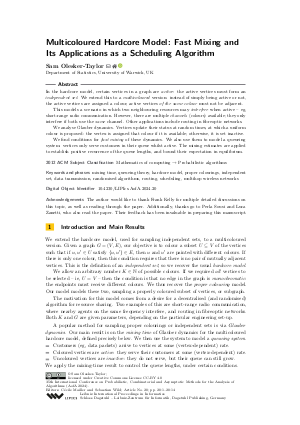@InProceedings{oleskertaylor:LIPIcs.AofA.2024.20,
author = {Olesker-Taylor, Sam},
title = {{Multicoloured Hardcore Model: Fast Mixing and Its Applications as a Scheduling Algorithm}},
booktitle = {35th International Conference on Probabilistic, Combinatorial and Asymptotic Methods for the Analysis of Algorithms (AofA 2024)},
pages = {20:1--20:14},
series = {Leibniz International Proceedings in Informatics (LIPIcs)},
ISBN = {978-3-95977-329-4},
ISSN = {1868-8969},
year = {2024},
volume = {302},
editor = {Mailler, C\'{e}cile and Wild, Sebastian},
publisher = {Schloss Dagstuhl -- Leibniz-Zentrum f{\"u}r Informatik},
address = {Dagstuhl, Germany},
URL = {https://drops.dagstuhl.de/entities/document/10.4230/LIPIcs.AofA.2024.20},
URN = {urn:nbn:de:0030-drops-204558},
doi = {10.4230/LIPIcs.AofA.2024.20},
annote = {Keywords: mixing time, queueing theory, hardcore model, proper colourings, independent set, data transmission, randomised algorithms, routing, scheduling, multihop wireless networks}
}

 Creative Commons Attribution 4.0 International license
Creative Commons Attribution 4.0 International license




